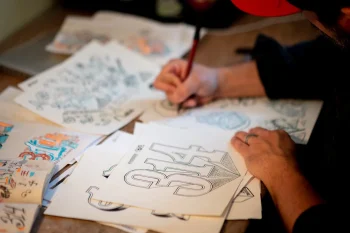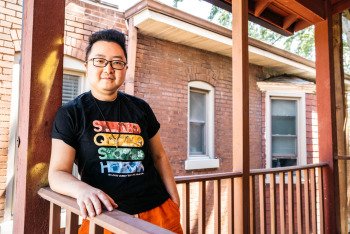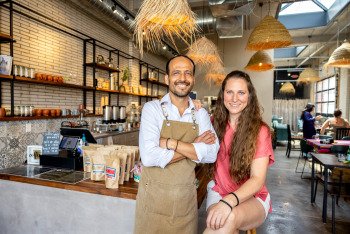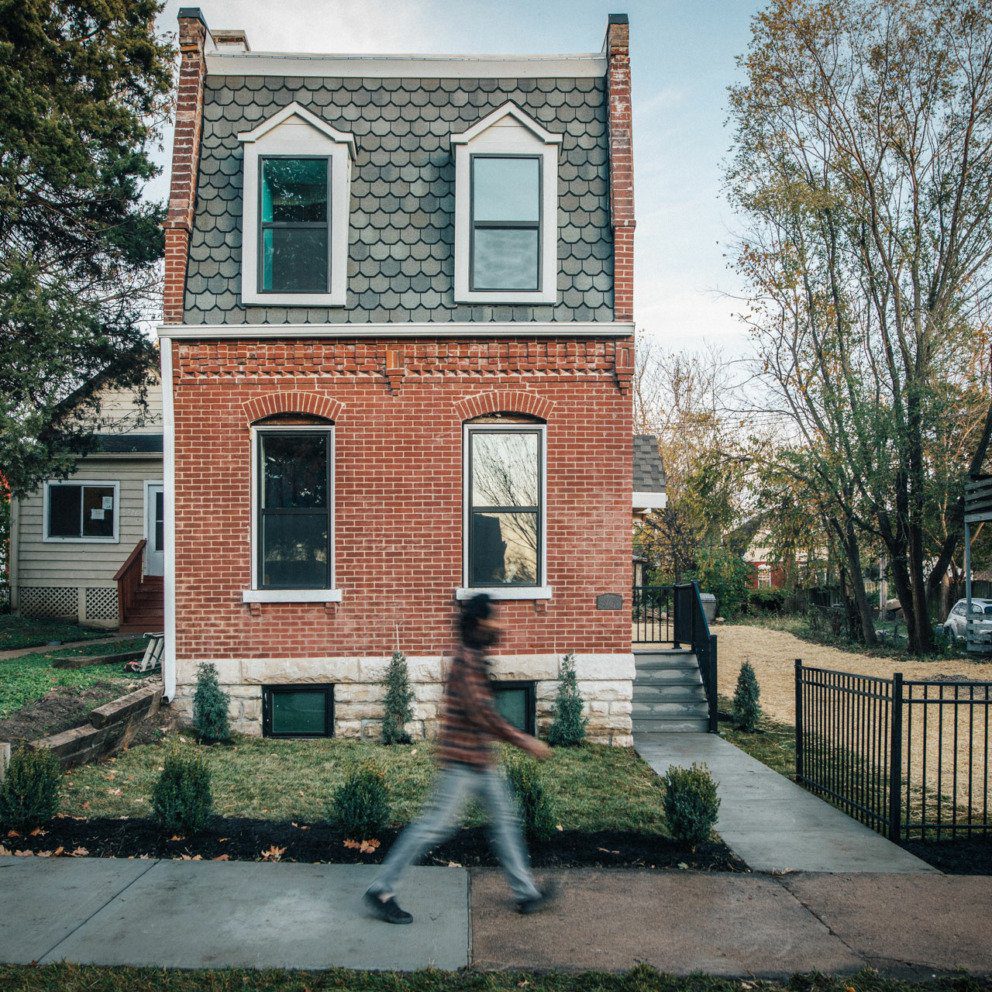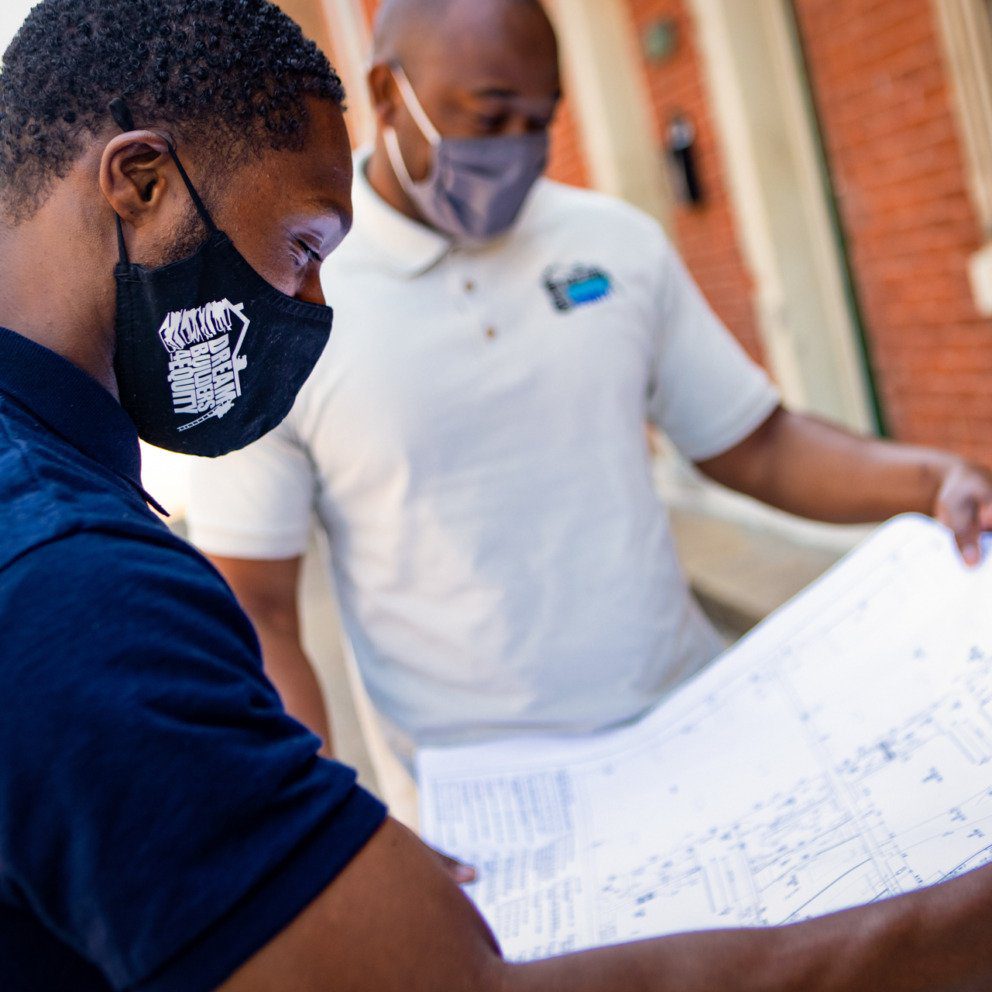Historical
Perspective
With unique bus and walking tours throughout the metro area, Amanda Clark helps people see St. Louis differently.
Amanda Clark stands in front of a squat, nondescript structure just across Market Street from Kiener Plaza in downtown St. Louis. Its weathered beige concrete walls make up a portion of the Hilton Ballpark Hotel’s exterior lobby, then extend down the block where they blend into the architectural landscape. The building looks insignificant, so when Clark stops in front of it, the presumption is that she will point to the Arch, the courthouse or the newly renovated fountains across the street. However, when she turns south to face its walls, the look in her eye denotes there is much more than what initially appears.
“This is the Spanish Pavilion, the second most visited pavilion at the 1964 World’s Fair,” Clark says. “It was moved here by Mayor Alfonso Juan Cervantes right after the fair. He negotiated with the autocratic Spanish government to have it disassembled and brought here from New York, and it sits on the site of the westernmost battle of the Revolutionary War, the Battle of Fort St. Carlos. It’s gone through all these transformations as people were less and less interested in it.
“But I love showing people this place, because I love showing that we have great architecture that was part of a big historical moment, hiding in plain sight.”
As community tours manager for See STL Tours, a program of the Missouri Historical Society, Clark has dedicated herself to helping people discover the pieces of St. Louis history that tell the city’s story in order to understand its past and unpack its present. Through walking tours that are unscripted and off the typical tourist path, Clark and her team of guides help to connect participants in their outings to St. Louis’ story, give context to its narrative and instill a passion for a city that, in all its complexity, is rich, deep and vital to the American story.
Though Clark may be one the city’s foremost experts on its history, she was not born into this heritage. A native of Tennessee who fondly recalls road trips to St. Louis as a child, Clark moved to town following college, thinking it would be a temporary stay until she fell in love with the area. Armed with a history degree with a special focus on architecture, she was perfectly poised to soak up the story of her adopted city, an interest sparked after her then-mother-in-law gave her a copy of James Neal Primm’s important work on St. Louis, “Lion of the Valley.” Intrigued by a particular anecdote about how parts of the Cahokia Mounds historical site were flattened and their dirt thrown into the river, Clark realized just how far back the history of St. Louis reaches, and she was determined to uncover as much of that story as she could.
As she attempted to learn more, she couldn’t help but feel disappointed that the stories she kept hearing were all the same. No matter where she went, it seemed that all people wanted to talk about was beer and the World’s Fair; though she understood these were important topics for the city, she knew there had to be more and began researching on her own. That’s when she had an idea.
“I wanted to do something on my own terms, because I felt all the stories being told were the same, and all the people telling the deeper stuff were at the academic level,” Clark says. “I knew there was this space where it could be academic and we could have fun with it too.”
In 2012, Clark used her research and burgeoning passion for St. Louis history to launch Renegade STL, a company that bucked not just the traditional way of conducting tours but also who gave them. In an industry dominated by older White men, Clark felt that being a younger woman would give the stories she was telling about the city a different filter and, together with her business partner Elizabeth Eikmann, she found an immediate interest in what she was doing. The company gained national acclaim for its unique – and sometimes irreverent – approach to historical tours, bolstering Clark’s vision to be a model for how other cities could tell their stories.
After eight years of running Renegade, the Missouri Historical Society approached Clark to see if she would be interested in building what she did with Renegade for their organization. It was an offer she couldn’t refuse, so in 2020, she came on board with the MHS to launch See STL, which both she and the society believe serves as a world-class template that other cities can emulate.
“What’s exciting about the Missouri History Museum and this coming together is that no other history museum in the country is doing this,” says Clark. “When I go to conferences or talk to people in other cities about what I do, they look at me with a really confused look, because it’s not normal for museums to have programs that get people to not come to the museum.
“My program takes people out into the city and acknowledges that history is still happening. There is something to be said for taking people to the places where history happened, and we are in a time period right now where we are looking at the complexities of stories and of the world we live in. And you can’t truly understand them until you go to that historic community, interact, engage in different ways and see it for yourself.”
On every tour she conducts, Clark is struck by what she calls “lightbulb moments,” the instances where she can see the connections being made in participants’ minds, the sparks of curiosity ignited or even the realizations that things are not as they immediately appear. She credits the tour’s unscripted nature that centers the participants in the conversation as the reason for this engagement.
“The thing that makes our tours different is the dialogue and that we get to know the people that we’re giving a tour to,” Clark explains. “When we start a tour and we say, ‘Hi, who are you? Why are you here?’ and we ask that question so that we can actually give you a tour that means something to you. And when you walk away from that experience, it meant something, and it will connect to your interest and connect us to you.”
Josiah Gundersen, a See STL participant-turned-tour guide, recalls his own lightbulb moments that occurred during his many outings as a tour guest. Like Clark, Gundersen is not a St. Louis native; he moved to the area from Seattle for college, and fell so in love with the city that he decided to stay. He credits getting out and about on the tours and actually feeling the sense of a place’s history as igniting his own passion for St. Louis, and he is thrilled that he can share that with others.
“What I love about See STL is getting to be in the places of history,” Gundersen says. “I think it’s really important to get to see the places and talk rather than just going to a museum that is disengaged from the setting. You get a better understanding of the complexity of each place, and it feels like there is an importance in engaging with people to understand that.”
See STL is not only different in that its setting is outside the museum; it is also different in where and how it conducts its tours. While many approach exploring St. Louis from east to west, beginning with the Arch and ending at Forest Park, See STL tours intentionally run north and south so that they can deeply explore many of the neighborhoods and historical landmarks that are often left out of discussions on St. Louis history. These include such outings as the “Old North” tour, which begins in the middle of the 14th Street Mall in front of Central Print and winds around St. Louis Avenue to a former public bath house, as well as the “Made in STL” tour, a manufacturing-centric exploration that begins on South Broadway and works its way up through the North Riverfront. Clark and her team are also working on programming new tours; one making its debut soon is “Queer Confluences,” exploring the area’s LGBTQ+ history.
In addition to the pre-set tours, See STL offers custom outings that allow participants to take a deep-dive into a particular area of interest. Both Clark and Gundersen have been struck by how, in recent years, organizations have reached out to explore their entity’s role in St. Louis history, fully aware that all they uncover might not be pleasant.
“We’re having more and more organizations and schools that want to put themselves in an honest place,” Clark says. “They want me to include their organization’s part in the movement west or ‘White flight’ or any of these topics, and they are open to being a part of the story. This gives people a space to process that and work through it, so it’s not just a tour with a script where I’m telling this information; there’s something to it, and there’s an experience to that. They want to look at history honestly and not leave it back there but take it forward as they experience St. Louis now.”
Clark believes that those connections are See STL’s fundamental mission, and she believes that the sparks lit on the tours are not just matters of curiosity but jumping off points for civic engagement. As she and Gundersen both drive home to participants on their outings, St. Louis history is not frozen in time, but is lived every day. Rich, fraught, complex and integral to the nation’s history, St. Louis’ story did not simply make us who we are but can serve as tool to make us who we want to be.
“I hope they want to know more; I want them to either go home and read some more or go connect with someone who lives in a neighborhood they want to know more about,” says Clark. “Connect with an organization. Go volunteer. We have all these connections to bigger American stories, and we’re a great place that either symbolizes or connects to them. So, connect with the historic communities and the history. That’s what I want people to do.”
Join the Story
- Book a See STL walking or bus tour for yourself.
- Learn more about “Hop Alley,” the former Downtown hub for Chinese immigrants.
- Read about the building of the Eads Bridge.
- Check out our story and video featuring historic preservationist Michael Allen: Preserving the Past, Shaping the Future.
- Read and watch HEC Media’s story on See STL Tours.
